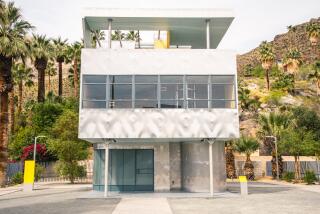Ain’s Contributions Remembered
- Share via
I never met Gregory Ain, who died a few weeks ago at the age of 79 after a lingering illness, but through his architectural designs and writings I knew him, and respected him.
From the 1930s to the early 1960s, Ain practiced and preached in Los Angeles a rare, humanistic architecture in which he considered design a tool to improve the lives of people and communities.
It is a design philosophy as appropriate today as it was then, and prompts a new appreciation of Ain’s struggle to produce user-friendly, affordable housing and well-planned neighborhoods. Certainly, he deserves to be listed among the architectural heroes of Los Angeles.
Despite lean years in the profession during the 1930s and ‘40s, Ain produced an impressive body of work in the spirit of his selfless social consciousness. This included dozens of innovative single-family and tract houses, a few office buildings and some distinctive apartment complexes.
Among those still to be seen and admired is a two-story, four-unit project at 1281 S. Dunsmuir Ave., just west of the Crenshaw District. Despite a narrow, sloping site, Ain, in a 1937 design, manipulated the cubist-styled units to create an open, informal plan focused on a row of private gardens.
The result, under severe constraints, was a modernistic update of the tried and true bungalow court, inexpensive housing sensitively rendered.
Though not a stylistic ideologue, Ain championed a modern design vocabulary that he embraced and had learned as an apprentice at separate times to both R. M. Schindler and Richard Neutra, two lions of the modernist movement. In his later writings and comments, Ain indicated that Schindler tended to be more sensitive to function and Neutra to style.
“Ain idolized Schindler,” recalls architect John Blanton, who for a time also worked for Neutra. “But Ain was more user-oriented; he wanted his designs to work for the clients, and therefore might compromise style. Because of this, clients loved him.”
Blanton also remembered Ain as an engaging and sympathetic teacher, an impression shared by others. Ain taught for a number of years at USC and in the mid-1960s, was dean of the school of architecture at Penn State. He returned to Los Angeles in 1967, but because of varying illnesses, sadly, never fully resumed practice or teaching.
In his prime, Ain continually tried to extend the modernist idiom to build affordable housing. It was a dream for which he won in 1940, at the age of 32, a coveted Guggenheim Fellowship to study low-income housing. Among his sponsors were the renowned Walter Gropius and Mies van der Rohe.
During this time, Ain also designed about 20 small, well-planned houses for middle-income families, who otherwise, because of no alternatives, would have most likely ended up in ticky-tacky tract models, according to architectural historian Esther McCoy in a definitive study of Ain included in her book “The Second Generation.” (The book is out of print but available through Hennessey + Ingalls, Santa Monica.)
McCoy notes that Ain “performed this service deep in the shadow of Neutra and Schindler, bringing to it a complexity greater than Neutra’s and a simplicity greater than Schindler’s.” She adds that “Ain was part of that small select group of the ‘30s--Harwell Hamilton Harris, J. R. Davidson, Thornton Abell, John Lautner--that gave substance, variety and surprise to the Los Angeles scene.”
In the 1940s, Ain continued to champion the need for well-designed, affordable housing in well-planned subdivisions, particularly to serve the flood of families expected in the postwar years. As a member of a jury judging a competition in 1945, sponsored by a national construction materials corporation, Ain warned that if architects did not meet this need, builders would, with poor designs.
Declared a report of the jury said to have been written in large part by the social-minded Ain, “too many architects in their zeal to promulgate new and frequently valid ideas withdraw from the common architectural problems of the common people.”
Definitely not withdrawing from the fray was Ain. With Simon Eisner as planner and Garrett Eckbo as landscape architect, Ain in the postwar years pursued the development of a 280-unit cooperative in Reseda. It was to be a model community, sensitively planned with parks and playgrounds and a variety of modern-styled housing for a mix of families. But because the mix included minorities, the project could not get the needed backing of the Federal Housing Adminsitration, and failed.
More successful was a tract development in Mar Vista, where as a principal in the firm of Ain, Johnson & Day, and in association again with Eckbo, Ain in 1947 planned about 100 houses on a 60-acre tract. But even there the FHA haunted him, reducing the number of units it would finance and requesting that in the interest of “good business practices,” ranch and salt box designs be mixed with his modernist schemes.
A persevering Ain eventually produced 52 compromised, partially prefabricated, 1,050-square-foot houses there that sold in the late 1940s for about $11,000 apiece, which was then a bit pricey for the area. Though the Mar Vista houses have been substantially altered over the last 40 years, they are still touted as an Ain design (and sell for about 20 times the original price.)
But in my opinion, it really is not the designs that distinguished Ain’s career, conscientiously rendered and accomplished as they were. What marked his work, and for which I am confident he will be remembered, was its motivation: The belief that design could, and should, be socially and environmentally responsible; indeed, that in its use there is an obligation to better serve mankind.
Such beliefs elevate architecture, and remind us of its marvelous and exciting potential. For that we thank, and remember, Gregory Ain.
More to Read
Sign up for Essential California
The most important California stories and recommendations in your inbox every morning.
You may occasionally receive promotional content from the Los Angeles Times.










